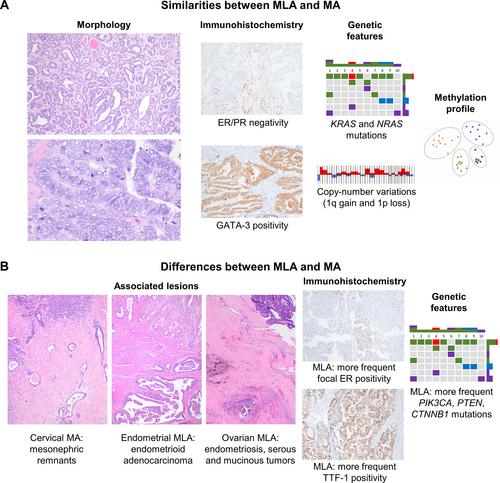下载PDF
{"title":"From morphology to methylome: epigenetic studies of Müllerian mesonephric-like adenocarcinoma reveal similarities to cervical mesonephric adenocarcinoma†","authors":"Lawrence H Lin, Brooke E Howitt, David L Kolin","doi":"10.1002/path.6285","DOIUrl":null,"url":null,"abstract":"<p>Mesonephric adenocarcinomas (MAs) and mesonephric-like adenocarcinomas (MLAs) are rare, aggressive neoplasms that arise in the gynecologic tract and show overlapping morphologic, immunohistochemical, and molecular features. While MAs occur in the cervix and are thought to arise from mesonephric remnants, MLAs occur in the endometrium and ovary and are believed to originate from transdifferentiation of Müllerian lesions. Both MAs and MLAs show a variety of architectural patterns, exhibit frequent expression of GATA3 by immunohistochemistry, and harbor <i>KRAS</i> mutations. In a recent article published in <i>The Journal of Pathology</i>, Kommoss and colleagues used DNA methylation profiling to extend these similarities and showed that MLAs and MAs cluster together based on their epigenetic signatures and are epigenetically distinct from other Müllerian adenocarcinomas. They also showed that MLAs and MAs harbor a high number of global copy number alterations. This study provides evidence that MLAs more closely resemble MAs than Müllerian carcinomas on an epigenetic level. As a result, the authors argue that MLA should be renamed ‘mesonephric-type adenocarcinoma.’ Further research is needed to establish the relationship between these two entities, their etiology, and pathogenesis. © 2024 The Pathological Society of Great Britain and Ireland.</p>","PeriodicalId":232,"journal":{"name":"The Journal of Pathology","volume":"263 2","pages":"135-138"},"PeriodicalIF":5.6000,"publicationDate":"2024-04-09","publicationTypes":"Journal Article","fieldsOfStudy":null,"isOpenAccess":false,"openAccessPdf":"https://onlinelibrary.wiley.com/doi/epdf/10.1002/path.6285","citationCount":"0","resultStr":null,"platform":"Semanticscholar","paperid":null,"PeriodicalName":"The Journal of Pathology","FirstCategoryId":"3","ListUrlMain":"https://onlinelibrary.wiley.com/doi/10.1002/path.6285","RegionNum":2,"RegionCategory":"医学","ArticlePicture":[],"TitleCN":null,"AbstractTextCN":null,"PMCID":null,"EPubDate":"","PubModel":"","JCR":"Q1","JCRName":"ONCOLOGY","Score":null,"Total":0}
引用次数: 0
引用
批量引用
Abstract
Mesonephric adenocarcinomas (MAs) and mesonephric-like adenocarcinomas (MLAs) are rare, aggressive neoplasms that arise in the gynecologic tract and show overlapping morphologic, immunohistochemical, and molecular features. While MAs occur in the cervix and are thought to arise from mesonephric remnants, MLAs occur in the endometrium and ovary and are believed to originate from transdifferentiation of Müllerian lesions. Both MAs and MLAs show a variety of architectural patterns, exhibit frequent expression of GATA3 by immunohistochemistry, and harbor KRAS mutations. In a recent article published in The Journal of Pathology , Kommoss and colleagues used DNA methylation profiling to extend these similarities and showed that MLAs and MAs cluster together based on their epigenetic signatures and are epigenetically distinct from other Müllerian adenocarcinomas. They also showed that MLAs and MAs harbor a high number of global copy number alterations. This study provides evidence that MLAs more closely resemble MAs than Müllerian carcinomas on an epigenetic level. As a result, the authors argue that MLA should be renamed ‘mesonephric-type adenocarcinoma.’ Further research is needed to establish the relationship between these two entities, their etiology, and pathogenesis. © 2024 The Pathological Society of Great Britain and Ireland.
从形态学到甲基组:对缪勒氏系膜样腺癌的表观遗传学研究揭示了其与宫颈系膜腺癌的相似性†。
间肾腺癌(MAs)和间肾样腺癌(MLAs)是妇科中罕见的侵袭性肿瘤,在形态学、免疫组化和分子特征上有重叠。宫颈间质瘤发生在宫颈,被认为是由肾间质残留物引起的,而子宫内膜腺癌则发生在子宫内膜和卵巢,被认为是由穆勒氏病变的转分化引起的。MAs和MLAs都表现出多种结构模式,免疫组化显示GATA3的频繁表达,并携带KRAS突变。在最近发表于《病理学杂志》(The Journal of Pathology)上的一篇文章中,Kommoss及其同事利用DNA甲基化分析扩展了这些相似性,并表明MLAs和MAs根据其表观遗传学特征聚集在一起,在表观遗传学上有别于其他Müllerian腺癌。他们还发现,MLAs 和 MAs 存在大量的全局拷贝数改变。这项研究提供的证据表明,在表观遗传学层面,MLA 比 Müllerian 癌更接近 MA。因此,作者认为 MLA 应更名为 "间肾型腺癌"。要确定这两种实体之间的关系、病因和发病机制,还需要进一步的研究。© 2024 大不列颠及爱尔兰病理学会。
本文章由计算机程序翻译,如有差异,请以英文原文为准。



